Windows Vista arrived on the market in early 2007.
The new features that it introduced have had a significant effect in the
Group Policy community. Windows Vista not only provides some impressive
new graphical enhancements, it also comes with some overall changes to
Group Policy that can affect the entire network of desktops—not just
single machines. (The exception is the Multiple Local GPO enhancements,
which do affect just one desktop at a time.) The new features that can
affect either one desktop or many desktops include the following:
Multiple Local GPOs
Some historical
background will help you understand what has changed with local GPOs on a
Windows Vista desktop. In previous versions of Windows, there was a
single local GPO on every server and desktop. Beyond the local GPO on
the individual computers, there could be many GPOs in Active Directory
linked to the domain, organizational units, and sites. The local GPO had
no power over the Active Directory GPOs unless nonconflicting settings
were established. In such a case, the local GPO settings would make
their way through the maze of Active Directory GPOs to the Resultant Set
of Policy (RSoP) that molded the final policy settings on the computer.
Multiple Local GPOs were
put into place in Windows Vista to solve many issues. One of the
biggest problems this feature solves involves handling the ability for
both users and administrators to log on to the same desktop, but be
treated differently. Before Windows Vista, if local GPOs were configured
to constrain the user account, both the administrator accounts and
regular user accounts would receive the constraining settings. This
caused some very odd results, either allowing the user to have too many
privileges or restricting the administrator too severely. If the
administrator needed to run elevated tasks in a restricted environment
like this, he or she was forced to use “Run As” or other
privilege-elevating technologies. Although this is an almost ideal
situation, it can cause some issues in companies that do not want such
restrictions on administrators logging on to desktops.
Windows Vista
tackles all of these issues with new technology related to the local
GPO. In reality, there is no longer just a single GPO on the local
desktop, but three local GPOs, which Microsoft refers to as Multiple
Local Group Policy objects (MLGPO). These three GPOs provide granular
control over the users who log on to the desktop. Local GPOs can be used
in a single-computer environment, home environment, small business
environment, or even large corporate scenario.
The three local GPOs
are designed to control desktop users in a hierarchical manner. This
hierarchy allows control over the settings that will be configured in
GPO. The three MLGPO options consist of the following, in their proper
hierarchical order:
Local Computer Policy Object
The
Local Computer Policy Object is identical to the local GPO in Windows
2000 and Windows XP. It can be accessed by using the Group Policy
Management Editor (by running Gpedit.msc from the Run dialog box) or
using the Microsoft Management Console (MMC). In either case, you can
control both Computer Configuration and User Configuration settings, as
shown in Figure 1.
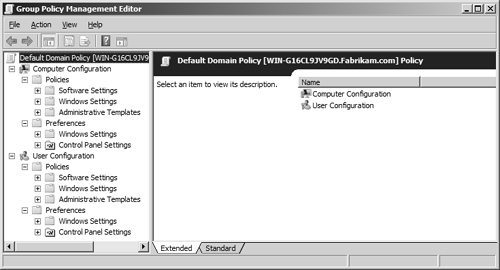
Administrators and Non-Administrators Local GPOs
The
Administrators local GPO and the Non-Administrators local GPO are new in
Windows Vista. As their names indicate, the GPOs in this layer are
designed to control two types of user accounts. The delineation is based
on which users have membership in the local Administrators group.
Note
User
accounts that belong to the Power Users group are not considered
Administrators and will not be affected by GPO settings under the
Administrators local GPO. Rather, they will be affected by the GPO
settings in the Non-Administrators local GPO. |
The reason for
this delineation is obvious. The settings for administrator-type
accounts and nonadministrator-type accounts should be different on a
desktop. Without these two options for local GPOs, it is nearly
impossible to make a distinction between these two types of user
accounts.
These two GPOs are not
easy to access, however. To access these GPOs, you must use the MMC.
This console exposes both of these GPOs so that administrators can
manage them, as shown in Figure 2.
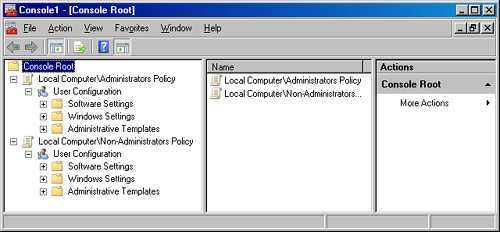
User-Specific Local GPO
The final local GPO
layer is the user-specific local GPO. This GPO offers definitive
granular control because it allows you to specify an individual user
account to receive
special GPO settings. Do not use this GPO option very often, because
individual user account settings are typically discouraged from an
administrative efficiency standpoint.
This type of GPO is very
useful on specialized desktops throughout the environment. Such desktops
might include those functioning as a kiosk, those in a training or
educational facility, or even those that have a shared user account. In
such cases, the user account used to log on to these special desktops
has a unique set of GPO settings, where all other user accounts are
controlled by the Local Policy Object or even the Administrators or
Non-Administrators local GPOs.
You do not
access the administration of this type of GPO through the Group Policy
Management Editor directly; rather, it is accessed through the MMC. When
using the MMC to open this GPO, you select the GPO that is associated
with any one of the local user accounts that are configured in the local
Security Accounts Manager (SAM). After you add your GPO into the MMC,
the interface will include only User Configuration settings. Because
this local GPO affects user accounts only, the MMC removes Computer
Configuration settings so that they do not confuse the administrator of
the local GPO. This can be seen in Figure 3.
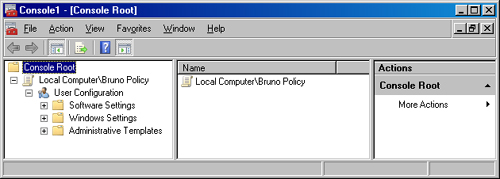
Precedence and Application
Now that there are
Multiple Local GPOs to configure and choose from, it is important to
understand how they are tiered in the hierarchy, in case there are
ever any conflicting settings among them. The hierarchy of local GPOs
is predetermined and creates the precedence for conflicting settings in
different local GPOs. The most generic GPO has the least precedence, and
the most specific GPO has the most precedence. Thus, the local GPO has
the least precedence, the user-specific local GPO has the highest
precedence, and the Administrators/Non-Administrators local GPOs fall
between these two. The order of precedence from lowest to highest is
summarized as follows:
The hierarchy of the
local GPOs must also coordinate with the GPOs that administrators link
with Active Directory. The same rules apply here as before, where the
local GPOs have the weakest precedence when compared to the GPOs from
Active Directory.
Network Location Awareness
The Network
Location Awareness technology that Windows XP delivered has been a
successful solution for many aspects of the operating system and network
connectivity. This technology allows the computer to be fully aware of
its state and communication capabilities, thus allowing it to make
intelligent decisions based on that state.
Group Policy has
historically relied on dependable, yet not the most impressive, network
identification technology. In the past, Group Policy has used the
Internet Control Message Protocol (ICMP) to determine the state of the
network, as well as network link speed. ICMP, which encompasses the PING
command, is great for getting some network information, but it has not
been ideal for helping Group Policy application.
Now that Group Policy
relies on Network Location Awareness, the overall picture and state of
Group Policy have been enhanced. Group Policy uses network location
awareness in two primary fashions: it determines link speed, and it uses
network location awareness to determine whether the computer needing to
refresh Group Policy is connected to the domain.
For the first
use of Network Location Awareness, Group Policy determines whether the
link from the computer receiving GPO settings has a fast or slow
connection to the domain and domain controllers. Because some GPO
settings can take a long time to apply because of the amount of data
being sent, determining link speed can be an indicator as to whether the
data should be sent at all. Network Location Awareness provides this
assistance by determining the bandwidth of a TPC connection. Group
Policy can then use this information to make decisions regarding the
settings that it should deliver based solely on the bandwidth available.
Group Policy also
uses Network Location Awareness for background refreshes. Network
Location Awareness indicates whether the computer has authenticated to a
domain controller and whether the domain controller is available to the
computer. This feature is important for computers
that have failed to refresh Group Policy because the domain controller
was not available. In the past, when Group Policy failed to apply, the
computer would wait until the next refresh interval—90 to 120 minutes—to
attempt to apply Group Policy. The domain controller might have been
available only minutes after the failed refresh, but the system would
wait the full refresh interval to apply the Group Policy updates. With
Network Location Awareness, the Group Policy refresh occurs as soon as
it detects the connection to the domain controller.
ADMX Templates
A change that surprised
some, but was needed, was a new form of administrative template. The old
ADM formatting was limiting in many ways, so a new format was
developed. The new format, based on XML, has more flexibility and power
than the old format. The new XML-based files have an .admx extension and
have changed substantially from their predecessors. A sample of the new
XML formatting is shown in Figure 4.
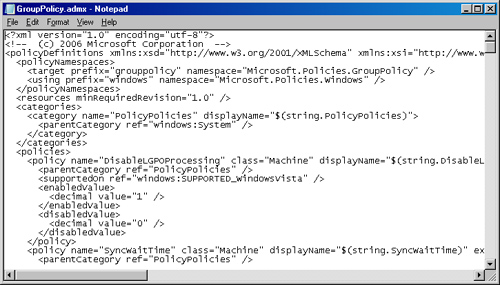
The XML formatting
was adopted primarily for its language flexibility. ADM formatting did
not translate into other languages, forcing other countries and
languages to use English, which is not always feasible. During migration
to the new format, the structure of the ADM files was radically
enhanced also. With the ADM structure, all settings lived in five ADM
files. Now there are 132 ADMX files that contain all of the
administrative template policy settings. Figure 5 shows some of these policy settings.
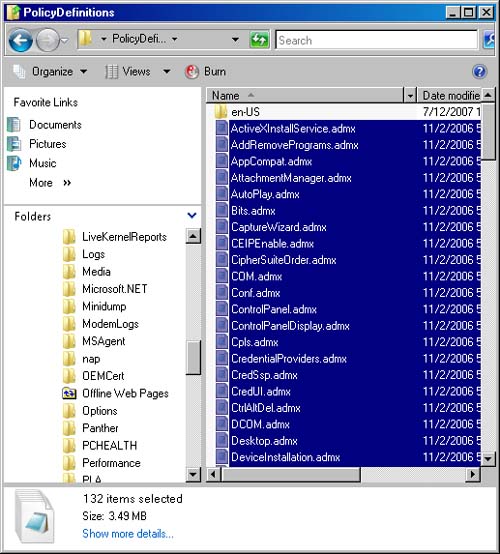
These
new ADMX files reside by default on the local system drive of computers
running Windows Vista and Windows Server 2008. The path to these ADMX
files is %SystemRoot%\ PolicyDefinitions, which is usually the default
C:\Windows folder that the operating system uses to store the system
files.
ADMX Repository
In conjunction
with the changes to the administrative template file structure and
formatting, GPO administrators create and utilize the central store so
that all ADMX files now reside in one location, instead of
administrators spreading these files throughout the network on their
local computers.
ADM templates were
difficult to control and manage, which is one of the major reasons for
the change. Another key reason involved how each GPO handled ADM
templates. Every GPO that administrators created copied the entire set
of default ADM templates into the location where GPO settings were
maintained (referred to as the Group Policy template). The Group Policy
template is located on domain controllers. Because there can be hundreds
or thousands of GPOs, the space required to store these ADM templates
was substantial. With each set of default ADM templates (coming in at a
massive 4 MB of data) being stored on domain controllers, this could
also add to replication traffic between domain controllers.
These
negative aspects triggered the development of new technology for
handling administrative template files. If an administrator does not
create the repository, the local ADMX files will still be used to edit a
GPO. This keeps the administration of GPOs consistent, even if the
technology is not used. It should be noted, however, that the ADMX files
are not
stored in the Group Policy template. This change helps with storage of
files on domain controllers, as well as the replication of those files
between domain controllers.
Improved Logging
It is no secret that
managing logging and documentation has been a struggle for Group Policy
over the years. Obtaining information from the old Event Log entries was
a bit problematic. You needed to be an expert in Group Policy and
Microsoft server technologies to get much from the logging that occurred
in the Event Viewer. The other logs, such as Userenv.log, were better,
but still not ideal.
All of this has
changed with the latest installment of GPO logging. The changes are like
many of the other changes: stunning and extraordinary. The new logging
is built within the updated Event Log service that is available with
Windows Vista. It disposes of Userenv.log and instead stores information
in a Group Policy Operational log found in Event Viewer. You can find
this log in Event Viewer by opening Applications and Services Logs and
then browsing to Microsoft\Windows\GroupPolicy\Operational. The
resulting log view is shown in Figure 6.

These new logs also
provide specific new features that help with extraction of information.
The logging technology provides for forwarding events to a central
location; this is called subscribing to an event.
Another benefit of the new log structure is the ability to filter views
of specific events, making mining information from large log files more
efficient.